|
Rosette Nebula in H-alpha enhanced color - Mar 4 & Dec 24, 2009
The Rosette Nebula is a large, circular H II region located near one end of
a giant molecular cloud in the Monoceros region of the Milky Way Galaxy. The
open cluster NGC 2244 is closely associated with the nebulosity, the stars
of the cluster having been formed from the nebula's matter. Both
the colour image and Ha
image acquired from my backyard in Victoria.
John
McDonald |
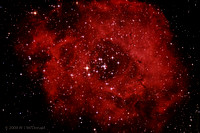 |
|
Widefield images of American Southwest - Dec 9-14, 2009 Iridium
flare, last quarter Moon, Jumbo Rocks, other celestial widefields taken from
Joshua Tree National Park and Death Valley National Park.
Charles
Banville |
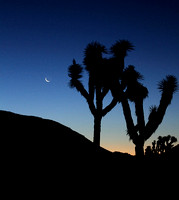 |
|
Horsehead in H-alpha enhanced color - Jan 17 & Dec 7, 2009
This is a color image of the Horsehead and Flame Nebulae that is enhanced
using a monochrome H-alpha image. Colour image acquired Jan 17, 2009 and Ha
image acquired Dec 7, 2009, both from my backyard in Victoria.
John
McDonald |
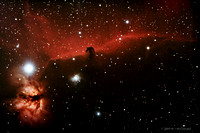 |
|
Veil in H-alpha enhanced color This image of the Veil Nebula,
NGC7960. is a combination of a color image taken with a modified Canon 350D
and a monochrome one through an H-alpha filter taken with a Canon T1i
John
McDonald |
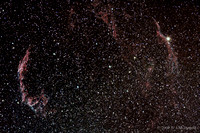 |
|
Viewing Session at the VCO - Oct 24, 2009
Victoria Centre members make use of their observatory on Observatory Hill.
Charles
Banville |
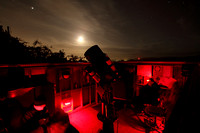 |
|
NGC 281, The Pacman Nebula in LRGB - Oct 10/11, 2009 This is my first combined image where Ha was used to enhance the color
image.
Guy
Walton |
 |
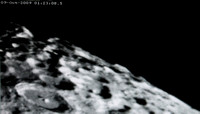 LCROSS - October 9, 2009
4:30am PDT
- The NASA LCROSS mission is to find water on the Moon. To that end, NASA
purposely crashed two space vehicles into a crater on the south pole of the
Moon on October 9, 2009, causing a plume to be ejected. Analysis of this
plume should determine if water exists in this area. Amateur astronomers
were encouraged to observe this event, since there was a possibility of
seeing the plume through larger telescopes. Several members used the
Victoria Centre Observatory to attempt to view this event. LCROSS - October 9, 2009
4:30am PDT
- The NASA LCROSS mission is to find water on the Moon. To that end, NASA
purposely crashed two space vehicles into a crater on the south pole of the
Moon on October 9, 2009, causing a plume to be ejected. Analysis of this
plume should determine if water exists in this area. Amateur astronomers
were encouraged to observe this event, since there was a possibility of
seeing the plume through larger telescopes. Several members used the
Victoria Centre Observatory to attempt to view this event.Observing
Report: Very early this morning, October 9, our LCROSS observing team
assembled at the VCO to observe and record the LCROSS impact experiment.
Team members consisted of Sid Sidhu, John McDonald, David Lee, Joe Carr,
Nelson Walker, Steve Pacholuk, Charles Banville, and myself. Bruno
Queneville was there as well doing his usual great job with the equipment
but left early due to work commitments later in the morning. Joe brought
donuts and coffee...the most critical component of any observing session.
Thanks Joe!
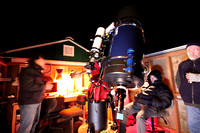 The weather was milder than expected at around +9C, with bands of clouds
passing through occasionally. We rolled the VCO roof back and spooled up the
14" Meade and David's video gear was attached and calibrated. The video
signal was streamed into David's netbook for recording, then on to an LCD TV
provided by John so all members could watch the impact easily. The club's
20" Dob was rolled out, Nelson set up his 15" Dob, Joe set up a small
reflector, and I set up a small refractor. As the morning progressed, some
members dialled in the video equipment while others used the outside scopes
to look at the Moon and well as Jupiter, M42, the Pleiades, and so on to
fill the time before the LCROSS impact time. The seeing was quite good
visually; transparency was good, steadiness and low to mid magnifications
was good. Due to the high magnifications used on the 14", however, the image
on the LCD TV monitor was turbulent. Atmospherics aside, the overall quality
of the video image was excellent. One desktop PC and two additional laptops
for monitoring NASA updates rounded out the gearlist. The weather was milder than expected at around +9C, with bands of clouds
passing through occasionally. We rolled the VCO roof back and spooled up the
14" Meade and David's video gear was attached and calibrated. The video
signal was streamed into David's netbook for recording, then on to an LCD TV
provided by John so all members could watch the impact easily. The club's
20" Dob was rolled out, Nelson set up his 15" Dob, Joe set up a small
reflector, and I set up a small refractor. As the morning progressed, some
members dialled in the video equipment while others used the outside scopes
to look at the Moon and well as Jupiter, M42, the Pleiades, and so on to
fill the time before the LCROSS impact time. The seeing was quite good
visually; transparency was good, steadiness and low to mid magnifications
was good. Due to the high magnifications used on the 14", however, the image
on the LCD TV monitor was turbulent. Atmospherics aside, the overall quality
of the video image was excellent. One desktop PC and two additional laptops
for monitoring NASA updates rounded out the gearlist.
About an hour before impact, the observers begain to gather inside the VCO
to begin the final countdown. The Meade was pointed at the exact correct
region of the Moon and we all concentrated on the crater Cabeus, centred on
the screen. David and Sid worked out key timing points for their recording
routine, and I called those out as the countdown progressed. Keys were
pressed, recording started, and anticipation grew.
Impact time was 04:32:19 PDT. This came and went with all eyes focussed on
the screen, but no discernable impact was noted. We watched and recorded for
several minutes after the scheduled impact time. By then, it was clear that
there was no major plume, at least visually on our screens. However, video
frames will need to be examined more closely to determine if there was or
was not any ejecta plume captured. (As I write this at 11:00am, it NASA is
reporting that no earthbound telescopes have observed a plume, and studies
of images and spectra are continuing.)
As we all know, even an experiment that produces no -or unintended- results
is still successful, and our success came from gaining valuable experience
in using video astronomy equipment at the VCO.
We were all tired. We quickly packed up and stowed all of our gear , locked
up the VCO, and headed for the next-most anticipated phase of the event:
sleep! Photos of the event will be available on our website shortly.
Thanks guys, that was fun.
Sherry. |
|
Mount Baker and Moon - Oct 4, 2009 A waning gibbous moon is rising above Mt. Baker, observed from Mt. Tolmie.
Winner of the 2009 Excellence in Astrophotography Award for
Victoria Centre.
Charles
Banville |
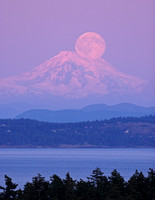 |
|
M27 The Dumbbell Nebula in Ha and OIII - Sept 26, 2009 - I finally
had a chance to image with some narrowband filters last night at the VCO.
I've been intrigued by narrowband ever since I read about the lack of
dependency on urban sky conditions and the possibility of more extensions to
human vision. I chose M27 for my first object as it is one of the popular
objects for this technique. It's amazing how different each band looks and
the structures it reveals. M27 is a planetary nebula marked by an
interesting pattern of knot-like structures in the central area.
David Lee |
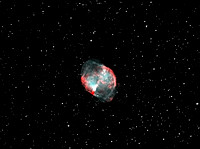 |
|
Pelican Nebula, IC5070 - Sept 24-25, 2009 Taken with an Orion
SSPro CCD one-shot colour camera from Victoria Centre Observatory through
the Centre's Tele Vue NP127is Apo chromatic refractor.
Guy
Walton |
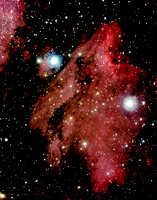 |
|
VCO & ISS - Sept 12, 2009 With the help of
Michel as a spotter, I was able to frame an International Space Station flyby from
inside the Victoria Centre Observatory.
Charles
Banville |
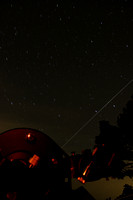 |
|
Last Quarter Moon - Sept 12, 2009 Taken from Pearson College
Observatory using a Tele Vue NP 127is and an SBIG ST 2000XM CCD camera with
CFW10 and LRGB Astrodon filters.
Charles
Banville |
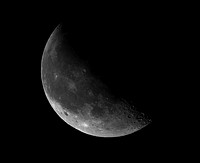 |
|
Deer Lick Group NGC 7331 - Sept 10, 2009
Taken at the Victoria Centre Observatory using the 14" Meade SCT.
This group of galaxies is dominated by NGC7331 which is 50M light years away
while the other members of the group are 10x further away.
John
McDonald |
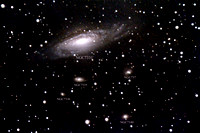 |
The Sun in Ha & a large solar prominence - August 31, 2009 4:34m PDT
Location: My front deck, Victoria, BC, Canada
This photo shows a large wispy and intertwined solar prominence enhanced by
using a Sobel edge detection operator.
Equipment: Canon 50D dSLR a-focal through a 2.5x Powermate & Lunt LS60THa +
LS50FHa solar telescope mounted on an HEQ5 tracking mount.
Joe Carr |
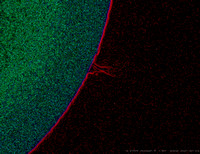 |
|
M52 and the Bubble Nebula, NGC 7635 - August 29/30, 2009 Location:
Victoria, RASC Observatory
Telescope and Mount: Astro Tech AT8RC telescope and EQ6 mount autoguided
with Orion SSAG camera and PHD.
Imaging Camera: Orion SSPro V1 controlled with Maxim DLE.
Guy
Walton |
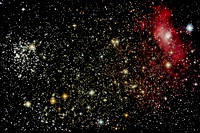 |
M13 Hercules Cluster - August 28, 2009 Location: Victoria Centre
Observatory, Observatory Hill, Victoria, BC, Canada
This image was created from a stack of 4 test images taken after a drift
alignment was done on the mount.1 exposure each at 2, 4, 8 & 15 minutes at
ISO 800, 800, 400 & 200 (respectively)
Equipment: Canon 50D dSLR mounted prime focus on a 14" Meade LX200 SCT operating
at f/10 mounted on a Paramount ME autoguided with an Orion autoguider using
PHD.
Joe Carr |
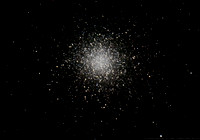 |
NGC 7635 Bubble Nebula - August 23, 2009 - the Bubble Nebula is a
ghostly emission nebula in the constellation Cassiopeia. It is approximately
10,000 light years away from us.
Location: Victoria Centre Observatory, Observatory Hill, Victoria, BC,
Canada.
Equipment: Modified Canon T1i prime focus on a Meade 14" SCT operating at
f/10 mounted on a Paramount ME, autoguided by an Orion StarShoot Guider and
PHD guiding softwareJohn
McDonald |
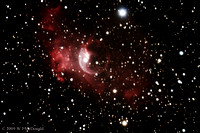 |
|
M27, The Dumbbel Nebula - August 19, 2009 Location - RASC observatory, Victoria, BC.
Equipment - Meade 14", Orion SSPro camera and Paramount ME mount autoguided
with SSAG and PHD.
Note: Autoguiding calibrated OK and appeared to be working but does not seem
to be effective.
Guy
Walton |
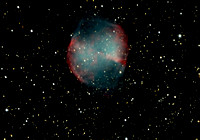 |
|
NGC 457 The Owl Cluster � August 18, 2009 This is an image of the
ET Cluster taken during the 2009 Mt Kobau Star Party.
Optics: TeleVue NP-127is f/5.2
Mount: Losmandy G-11
Camera: SBIG ST-2000XM
Charles
Banville |
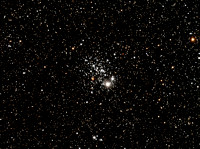 |
|
NGC6888 - the Crescent Nebula - August 12, 2009 - This image of the
Crescent Nebula was taken the night before the 2009 Saskatchewan Summer Star
Party. I am pretty happy to have captured it as we only had a few hours of
dark sky the whole week. Location � Cypress Hills at the Saskatchewan
Summer Star Party.
Equipment � William Optics 105mm apo with modified Canon T1i on HEQ5 mount.
John
McDonald |
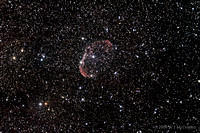 |
M51 - QSI 583c test - July 26, 2009
Location: Victoria Centre Observatory, Observatory Hill, Victoria, BC,
Canada
This is a first light image from Victoria Centre's new QSI 583c CCD camera.
Equipment: QSI 583c CCD imager prime focus on a Meade 14" SCT operating at
f/10 mounted on a Paramount ME, autoguided by an Orion StarShoot Guider and
PHD guiding software
Image Acquisition: CCDSoft - both light and dark frames, & camera control
Exposures: 12 x 5 minutes light frames, 7 x 5 minutes dark frames, cooled to
5�C.
Size: 3324x2502 pixels - original size from the CCD camera
 | Top-most image
is original processed by
Joe Carr |
 | Middle image is Joe's fits resultant image reprocessed by
Guy
Walton |
 | Bottom image is Joe's jpg resultant image reprocessed by
John
McDonald |
|
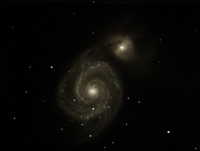
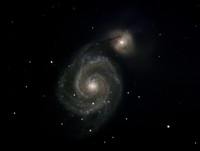
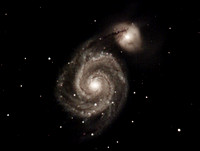 |
|
Spiral Galaxy, M101 - July 24, 2009 - This photo is first light
with a new Astro-Tech 8" f/8 Ritchey-Chretien Telescope. Collimation is off
a little and has to be refined. I like the extra focal length and with
experience the images should be much sharper.
Guy
Walton |
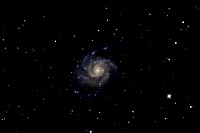 |
|
Moon and Trees at the VCO - July 24, 2009 - From the Victoria Centre
Observatory site the Moon was setting for a night of viewing and
photography. It was a wonderful way to start the evening. Malcolm
Scrimger |
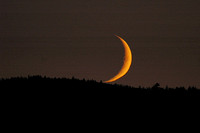 |
|
Ganymede Shadow Transit of Jupiter - July 22 2009 - Early this
morning I woke up around 2:40am, it must have been thoughts of getting a
glance at a visible collision on Jupiter. Not having planned on this I just
grabbed my Pronto and set it up on a tripod. Much to my surprise I could
clearly see a sharp round shadow on the face of the planet. Obviously a
shadow transit of the moon Ganymede. I looked around and I could see the
Great Red Spot and a slight brightening nearby. I found out later this was
Ganymede itself. Wanting to go back to bed I didn't want to get the rest
of the imaging gear out so I grabbed a piece of paper to sketch what I saw
and later translated this to an illustration that I created with Photoshop.
David
Lee |
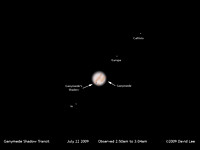 |
|
Abell 2151, Hercules Cluster of Galaxies - July 19, 2009 - I was
inspired by
Bill Keel's work on Abell 2151 and wanted to take advantage of the dark
skies while attending the Island Star Party to take a deep field photo of this fascinating area of Hercules. This photo shows Bill's area of study in a
wider field - his photo would cover a smaller area near the bottom centre of
my photo. There are numerous interacting galaxies to be found in this area,
which results in some bizarre shapes. I included a much wider field, because
upon examining my photos I realized that although the action is concentrated
in the area examined by Bill, the outer fringes also yield some very
interesting galaxies.
Joe Carr |
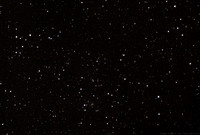 |
|
IC 5146 The Cocoon Nebula - July 18, 2009 - An image of the Cocoon
Nebula taken during the 2009 Island Star Party. This is my first published
picture taken with my new SBIG monochrome camera and 5� refractor. This set
up brings more details in the nebula as oppose to some past wide field
images I took where the dark nebula Barnard 168 was the centre of attention.
Also visible in this image is the smaller reflection nebula VdB 147 located
west of IC 5146.
Charles
Banville |
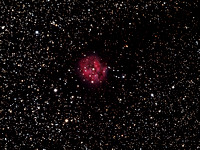 |
|
Cygnus Study - July 18, 2009 -
Wide field study of
the Cygnus region using a 50mm lens to obtain 5 images covering the whole
constellation and surroundings. This mosaic
obtained by combining five individual images taken at the Island Star Party. John McDonald |
 |
|
M63, Sunflower Galaxy - July 3, 2009 - It is easy to see how the
Sunflower Galaxy was named. This unbarred spiral galaxy in Canes Venatici
includes many short spiral arms containing star forming regions. These arms
appear blue in more detailed photos of this object, and also a distinct
yellow core would be visible. My photo captured little colour...probably
because the sky was awash with a 12 day old Moon.
Joe Carr |
 |
|
Solar Flares - June 29, 2009 - I mounted my Lunt solar telescope on
my HEQ5 tracking mount, since it was a lovely clear afternoon to observe the
Sun in Ha. Visually, these flares were hard to see, but I was rewarded with
some photos showing some very nice detail.
Joe Carr |
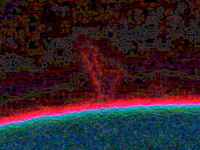 |
|
M57, the Ring Nebula - June 5, 2009 & June 27, 2008 - the Ring Nebula is a colorful bubble of glowing material ejected from a
dying star. The remaining star core is seen in the center of the bubble.
There is a lot of H alpha light coming from this planetary nebula so I have
combined my results from Friday with those I got last year using a modified
camera that is more sensitive to the H alpha wavelength. The combination is
quite colorful as you can see.
John McDonald |
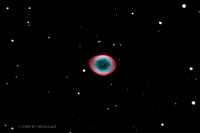 |
|
Spectrum of Vega : Spectral Type A0Va - June 2, 2009 - This is my
first stellar spectrum of Vega. It was created with a Star Analyser 100
grating and is one of the easiest ways to start investigating spectroscopy.
Being an early attempt I haven't quite mastered the focus but I'm amazed by
how forgiving this is. The hydrogen balmer lines are quite evident and the
imaging procedures were quite simple.
David Lee |
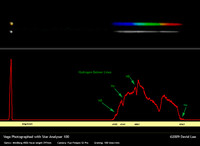 |
|
The Eyes and Neighbours - NGC 4456 and 4461 - May 21, 2009 are the
interacting galaxies in the centre of the frame. They are part of the
Markarian chain, a rich collection of galaxies in Coma Bernices. 18 galaxies
are visible in this image.
John
McDonald |
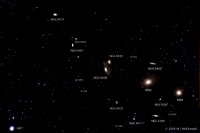 |
|
M3 -
May 9, 2009 - taken from Springwater
Observatory, Salt Spring Island. 12� LX200 and SBIG XCM4000. 18 exposures
at 10 minutes each. Processing: Registar and Photoshop
Don van
Akker |
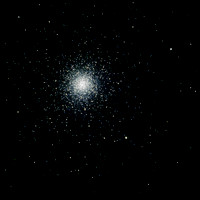 |
|
M51 Whirlpool Galaxy - May 2, 2009 - taken from Springwater
Observatory, Salt Spring Island. 12� LX200 and SBIG XCM4000. 18 exposures
at 10 minutes each. Processing: Registar and Photoshop
Don van
Akker |
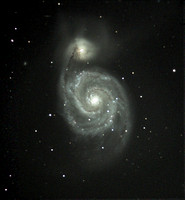 |
|
M51, The Whirlpool Galaxy - April 30, 2009 - taken from L.B. Pearson
College of the Pacific, near Metchosin, BC. The moon was fairly bright
but I don't think it was a factor. Notice the small galaxies to the right of
M51. This image is a slight cropping of the original. Optics: Equinox
120mm refractor on an EQ6 mount autoguided with an Orion AG camera and PHD.
Imaging Camera: Orion SS Pro Color, controlled with Maxim DLE software.
Guy
Walton |
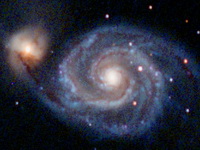 |
|
Titan shadow transit of Saturn - April
29, 2009 - Late in the evening of April 28/09 I had the opportunity
to watch a second Titan shadow transit. The conditions were far from ideal
with a very light haze and less than optimum seeing. I set up both my 12.5"
and 6" dobs to observe the event. I picked up the first sighting of the
shadow on the limb of the planet at just 0631 UT as an indentation on the
edge. It reminded me of the beginning of the transit of Mercury a few years
back. This observation was one of the highlights of my observing life,
seeing as 50 years ago on April 29th, my own shadow began to fall on this
planet. Bill
Weir |
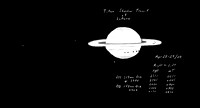 |
|
Venus and Moon Occultation - April 22 2009 - The photo op this
morning at Cattle Point was almost a total washout. When I arrived at 5:10am
the dark clouds were still covering the area where Venus and the Moon were
hiding. This is not uncommon for events like this unfortunately. Just before
the occultation I did get a few glimpses as you can see from the images. I'm
glad I did get some visual views through the telescope before this. It was
quite stunning to see a Crescent Venus alongside the Crescent Moon.
Unfortunately I couldn't capture this in the images.
David Lee |
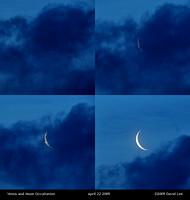 |
|
Twin Crescents - the Moon & Venus - April 22, 2009 - The way
things looked a few minutes prior to Venus being occulted by the Moon as
observed from Mount Tolmie Park, Victoria.
Charles
Banville
|
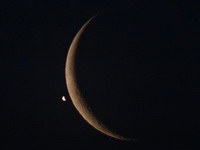 |
|
Saturn and Four Moons - April 21, 2009 - Inspired by the seeing at Brentwood Elementary (School Observing Program) I
set up when I got home. The views of Saturn were amazing especially with the
moon Titan so close to the planet. I knew imaging wasn't going to be easy
given I was using the refractor with the 5x Powermate. The high
magnifications required to get a decent image size makes for a dim object
for video. However I was glad I tried as it is possible to do with a 4"
refractor. When I stretched the image I could also make out some other
moons. To make them obvious I used the Solarize filter in Photoshop. There is
a moon missing, Mimas but I could see it was just on the boundary of
perception. Mag 13 for the refractor was the limit given the fast exposure
of the video frames.
David Lee |
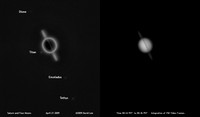 |
|
Supernova 2009dd in NGC4088 - Apr 15, 2009 - Bright supernova 2009dd
is clearly visible in the centre of NGC 4088, the large galaxy in the
frame. A smaller galaxy NGC 4085 is just visible on the right side of the frame. Taken
through the Meade 14" SCT operating at f/10 at the Victoria Centre
Observatory.
Joe Carr |
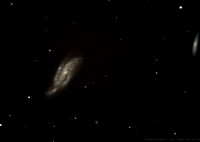 |
|
Supernova 2009dd in NGC4088 - Apr 15, 2009 - On the morning of Apr.
15/09 I read a report announcing a new supernova had been discovered in the
galaxy NGC 4088 in Ursa Major. Happily the weather cooperated an on that
same evening I was able to observe and sketch the galaxy with the supernova.
The SN is the Little White Dot at almost the very centre of the galaxy. Bill
Weir |
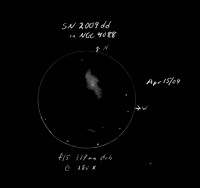 |
|
Titan shadow transit of Saturn - April 13, 2009 - One Little Black dot -
on April 13, 2009, on and off between 01:30 and 01:50 PDT there were enough
cracks in the clouds and thankfully no rain in between, to allow some views
of the shadow transit. At 01:50 PDT (UT 08:50) I was granted a long enough
clear spell to do this sketch.
Bill
Weir |
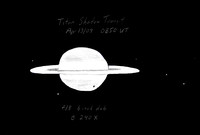 |
|
|
|
Messier Marathon - March 25/26, 2009 I really enjoyed my first
Messier Marathon. I decided beforehand that I would take my time, since as
many of you know, I'm more of a "goto" than a "push to" observer. That said,
I brought along 9x63 binoculars and a 6" Dob to use for the evening - along
with the excellent lists and charts that Nelson referred us to from
our website.
The evening started out in spectacular fashion. Everyone started the session
at the Victoria Centre Observatory, and we were all treated to seeing the
International Space Station fly overhead, and the Space Shuttle preceded it
at 8:10pm. I would have gone home happy just to observe this event! After
observing a few of the brighter Messiers from the VCO (but missing the first
3 - M74, 77, 33), both Bruno and I drove back down to the lower parking lot
to setup for the evening/morning. I had previously setup my motor home down
there, so the coffee was made, the heater was on, and the red lights were
rigged.
I observed a total of 34 Messier Objects, with my first observation being
M45 from the VCO at 8:20pm in the evening, and my last observation being M67
from the lower parking lot at 4:25am the following morning. After packing up
my observing gear and the motor home, I was the last to leave Observatory
Hill at 5:30am.
Lessons learned:
- Use binoculars to find objects. This will increase productivity,
since most Messiers are visible in binos.
- Keep the telescope gear simple - my Dob worked well, as did others
using alt/az "push to" mounts. Others who tried to use EQ mounts were
slowed by the technology, and many became frustrated.
- Having the motor home nearby provided welcome respite from the cold.
Personally, I would not have lasted the night without this "warm room".
- Nelson advised us to plan ahead. Reviewing charts and lists,
practicing with new gear beforehand, and spec'ing out the observing
sites paid off with increased productivity when the time came to
observe.
I enjoyed the challenge of departing from my usual way of observing, and
seeing the ISS and Space Shuttle was just icing on the cake!
Joe Carr |
|
Mini Metchosin (Messier) Marathon - March 25, 2009 It was more of a
sprint than a marathon actually. Early on I hadn't expected much of the
evening after being shut out of a viewing of the thin crescent Venus by thin
clouds to the west. Then there was my son's band concert that I needed to
attend. With arriving home at 2100hrs and seeing the sky perfectly clear I
threw my 6inch dob, a simple atlas and the Messier marathon order list into
my truck and headed out. I drove straight to the Metchosin cricket pitch,
which has the best 360� view of the sky in the area. I was dismayed to see
that the parking lot light for the little Community house was on. This is
the most retardedly designed light they could possibly think of installing.
It beams like a death ray into the sheltered spot where I like to set up.
I'd never noticed it before. This is a spot that is usually sheltered from
the lights on the municipal and fire halls.
My aim for the night was to see how many Messier objects I could find using
only the marathon order list and no maps. I set my time limit at midnight
because I had to work today. By 2130 I was aiming my scope towards the west.
I decided to bypass the first two objects on the list (M77 and 74) and went
straight on from there. It was only after I had finished up in Perseus that
I realized the part of Pisces that I needed had been still above the
horizon. Taking a shot I pointed the scope directly where I knew M74 should
be. I was greeted with the small core of the galaxy along with the outline
of the distant hill also in the FOV. M77 was gone below the horizon but I
now wonder that if I had tried right in the beginning, it might have been a
go.
It was a wildly successful evening. My grand total was 67 Messiers seen, by
the time I ran out of sky at 2315hrs. The final object was M92 in Hercules.
It was totally in the hazy muck over top of the city off to the east. I had
to sweep it up first with my 10X50 binos because there were no stars visible
close to it. All that I could make out was the Keystone". This is object #70
on the order list. The objects I couldn't see were M77 & M83 both below the
horizon and M79, which was blocked by some trees at the SW side of the
field. I have a feeling that M79 might have been possible if I'd have gone
for it earlier or remembered to try for it a little later when it might have
moved past the trees.
I only had to look up 3 objects, M93, M61 and M68, so I was very pleased
with that.
By the time I threw everything back into my truck the black metal tube of my
little dob was totally frosty white. I was home and totally unpacked by
2330hrs. Man that was a very productive 2hrs well spent.
I'm hoping to hear that the crew who went up on the hill had an even better
night, seeing as they were planning on an all-nighter. I expect to see high
number counts. I'm looking forward to next year. If I make any progress on
the lighting in the area, perhaps were could do the Marathon out here.
Bill Weir |
|
Mount Tolmie sunset and sundogs - March 12, 2009
It's always nice to keep a camera with you as you never know what you may
come across. The view was unforgetable, so I wanted to capture it for all to
enjoy.
Malcolm
Scrimger |
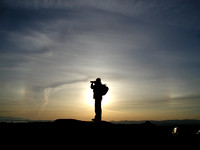 |
|
Comet
Lulin with the Beehive - March 5, 2009
Comet Lulin cruised just a couple of degrees south of the Beehive cluster.
Despite the 70% Moon shining not far away down amongst the feet of Gemini
this nice little comet still had a bit to show. I could even make out a bit
of a stubby tail extending to the east. The bright star in the bottom right
of the sketch is delta Cancri
This is how I observed it using my little f/6.8 ED80 refractor at 13X. The
FOV is approximately 4�.
Bill Weir |
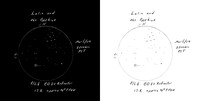
|
|
The
Crux and Carina constellations - Feb 27, 2009
Location: La Ensenada Lodge, Gulf of Nicoya, Costa Rica
(L to R)Southern Cross and Coalsack dark nebula, IC2944/8 nebula, Stock 13
cluster, the Eta Carina nebula, and the Southern Pleiades cluster (IC2602).
Joe Carr |
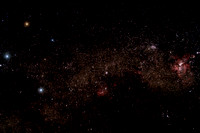 |
|
Overnight at La Ensenada Costa Rica
- Feb 26, 2009 from
RASC Victoria Centre
Taken
from La Ensenada Lodge located on the Gulf of Nicoya in Costa Rica. The
camera was set to shoot a sequence of images every 30 seconds all night and
the results were turned into this high definition video.
John McDonald |
|
|
Deep image of the Eta Carina Nebula - Feb 25, 2009
The most prominent star in the bright
section of the Eta Carina Nebula is eta carina, an unstable giant and currently the
most massive nearby star that can be studied in great detail. It produces
produce more than a million times as much light as the Sun and could go
supernova any time. Since its light takes 8,000 light years to reach us it
may have already done so.
Date and Location - 2009-02-25 at La Ensenada resort in Costa Rica.
Details:
Modified Canon 350D with a 300mm lens on astrotrack mount.
Exposure - 37 125s light frames, and 20 darks at ISO 800 and f/4 with 8
flats for calibration.
Processing in ImagesPlus and Photoshop.
John
McDonald |
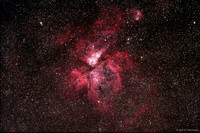 |
|
Comet Lulin - Feb 25, 2009 Comet Lulin was an unaided eye sight
from the dark skies of Costa Rica, although it was more spectacular in
binoculars. The star trails illustrate just how fast this comet was moving,
since the series of 31 stacked images is aligned on the comet's head.
Location: La Ensenada Lodge, Gulf of Nicoya, Costa Rica
Joe Carr |
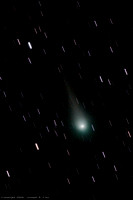 |
|
Deep field image of the Orion Nebula region- Feb 24, 2009
The Orion Constellation with all the showpieces: M42, M43, Rosette
Nebula, Witch's Head, and the beautiful Barnard's Loop. Location - La Ensenada resort in Costa Rica.
John
McDonald |
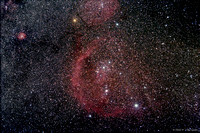 |
|
Crescent Moon, Mercury, Jupiter, Mars conjunction - Feburary 23, 2009 5am
CST Comet Lulin was an unaided eye sight from the dark skies of
Costa Rica, although it was more spectacular in binoculars. This is a
resultant image from a series of 31 images taken just before sunrise. The
star trails illustrate just how fast this comet was moving, since the series
of photos is aligned on the comet's head.
Location: La Ensenada Lodge, Gulf of Nicoya, Costa Rica
Joe Carr |
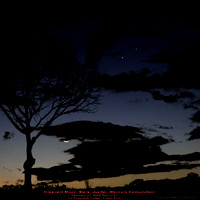 |
|
February Night Sky from Fairfield
- Feb 9, 2009 from
RASC Victoria Centre
34 second timelapse video of the February Night Sky from my back yard. Pleiades, Taurus, Orion all cross the sky before the full moon blows everything out of the water. Date - Feb 9, 2009 in Fairfield backyard, Victoria BC
Camera � tripod mounted Canon 350D with 10-20mm lens set at 10mm
Exposure � 30 sec at ISO 800 with auto aperture.
Duration 6:10 PM PST to 9:19 PM PST
John McDonald |
|
|
Solar
flares in Ha band - February 9, 2009
-
It�s rare but not unheard of in February � the Sun was
out this afternoon, and it was clear of clouds for a couple of hours. I
took advantage and setup my new Lunt solar telescope on the back deck and was rewarded with some quite spectacular solar flares.
Joe Carr |
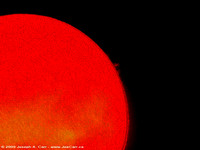 |
|
Iridium Flare over Death Valley - Jan 31, 2009 -
After getting the proper timing, altitude, and azimuth, I was finally able
to capture an Iridium flare on my fourth attempt.
Taken with a Canon 20Da
and Canon EF 17-40mm f/4L USM used at 40mm on a tripod.
Charles
Banville
|
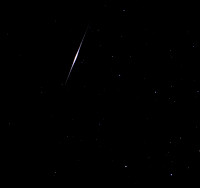 |
|
Star Trails � Polaris over Death Valley - Jan 29, 2009 - three
hours' worth of exposures taken from Death Valley National Park in
California. Taken with a Canon 20Da
and Canon EF 17-40mm f/4L USM used at 17mm on a tripod.
Charles
Banville
|
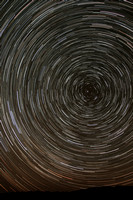 |
|
Barnard's Loop & Sharpless 2-264 - Jan 27, 2009 -
The nebulae Sharpless2-264 and Barnard�s Loop (Sh2-276) are revealed in this
two-hour-long-exposure. A faint glow of the Witch Head Nebula can be seen in
the lower right corner of this image. exposures taken from
Mojave National Preserve in
California.
Taken with a Canon 20Da
and Canon EF 17-40mm f/4L USM used at 40mm on an HEQ5 mount.
Charles
Banville
|
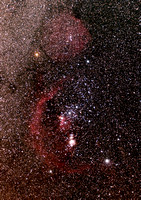 |
|
Comet C/2007 N3 Lulin - Feb 3, 2009 -
taken from Death Valley National Park in California, Comet Lulin`s two tails
are clearly visible in this image. The bright orange star is Nu Librae.
Taken with a Borg 77ED II at f/4.3 on a HEQ5 using a Canon 20Da.
Charles
Banville
|
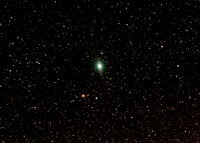 |
|
Comet Kushida 144P - taken Jan 20, 2009 - taken from the Dominion
Astrophysical Observatory. This comet is currently in the constellation
Taurus. Taken with a Borg 77ED II at f/4.3 on a HEQ5 using a Canon 20Da.
Charles
Banville
|
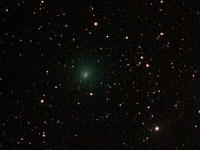 |
|
Rosette Nebula, NGC2237 - Jan 17, 2009 -
taken at the Dominion Astrophysical Observatory using a Sky Watcher Equinox
120mm ED refractor using an Orion SS
Pro Color CCD camera mounted on an auto-guided EQ6.
Guy
Walton |
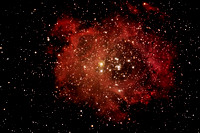 |
|
Horsehead and Flame Nebulae - Jan 17, 2009 -
This is my third and most successful attempt to capture the Horsehead and
Flame region of the sky and its subtle nebulosity. Taken from my backyard.
John
McDonald |
 |